This summary of the keto experiment covers the following:
- What the Keto Experiment Was and Why We Did It
- How the Experiment Was Run
- The Keto Experiment Results
- Analysis: What Could Explain These Results?
- What About Quest Bars?
- Quest Bar Test Results
- Post Analysis – Strengths and Limitations
- Summary: The Takeaways
What the Keto Experiment Was and Why We Did It
The Ketosource team ran a small crowd experiment with members of the Keto London Meetup community. The aim of the study was to test the blood ketone responses to different types of popular low carb bars.
We wanted to know:
- Can you eat a low carb bar and still stay in ketosis?
- Which bars, if any, will keep you in ketosis?
There are a number of ‘low carb-high protein’ bars on the market. Because of this, many people believe them to be ‘keto friendly’. However, this may not always be the case.
Increased blood ketones are not necessary for everyone. However, many people still look to avoid foods that ‘kick them out of ketosis’. We wanted to test the most popular bars to see whether they really were ‘keto’.
To be a true ‘ketogenic’ food, it should not decrease ketone levels in the blood. Being so convenient, it’s important for people to know what these bars are really doing to blood ketone levels.
What does the research say?
Previous research looking at similar protein bars showed low protein, fat and carb-based bars impaired glucose compared to high protein, low fat bars [note] Williams, G., Noakes, M., Keogh, J., Foster, P., & Clifton, P. (2006) High protein high fibre snack bars reduce food intake and improve short term glucose and insulin profiles compared with high fat snack bars. Asia Pac J Clin Nutr, 15(4), 443-450. , 8[/note].
This was, therefore, an opportunity to compare the “Low Carb High Protein” bar format to a new “High Fat High Fibre” bar format (The Ketone Bar).
How the Experiment Was Run
What Was Tested?
Participants ate 120g (two bars) which were randomly allocated to them. This higher gram amount ensured we saw a clear signal of each bar’s blood ketone response.
We randomised nine volunteers to one of the three bars:
- Two volunteers consumed a ‘Nature’s Plus KetoSlim Bar’
- Three volunteers consumed a ‘Grenade Carb Killa – White Chocolate Mocha Flavour’
- Four volunteers consumed a ‘Ketosource Ketone Bar’
Table 1: Three bars used in the experiment and their dosage
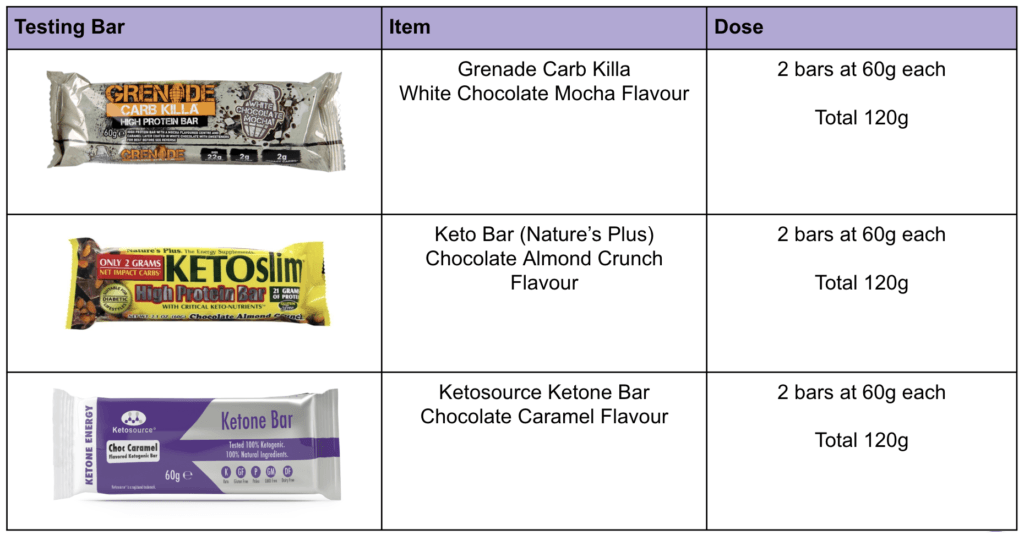
How Did We Prepare For The Experiment? Who Did It?
The team recruited nine volunteers following a keto diet in the weeks leading up to the event. It was essential that they were following a keto diet in order to test the impact of the bars on a state of ketosis.
Participants received a brief overview of what the study would entail. A week before the event they completed a survey to determine whether they were eligible to take part.
The eligibility survey covered the following areas:
- Gender
- Weight
- Height
- Any and Which ongoing health issues
- Any and Which medications and supplements taken
- Whether participants were on or off a keto diet
- Whether participants would be in ketosis on the day of the study
- For the purpose of this study, ‘ketosis’ was a blood ketone level of 0.5mmol
How Did We Do The Experiment?
Figure 1. Overview of the Testing Procedure
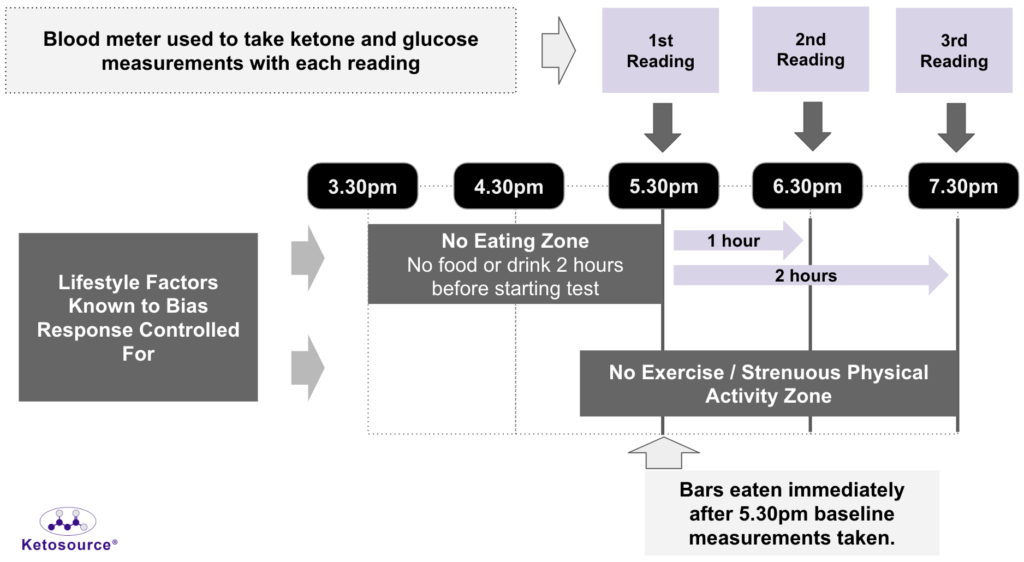
Participants fasted for two hours prior to eating the bars. They then completed a pre-test survey to address potential confounders to the study such as:
- Sleep
- Energy
- Illness
- Weight
- Current Medication
- Time Finished Last Meal
- Any Pre-Test Exercise (previous two hours)
One hour after eating, the team took further measurements of blood ketones and again at the two hour mark. This was so that we could determine the blood ketone response of each bar. Analysis of results used basic statistical tests. These compared changes in ketone levels and identified any differences between the bars.
The Keto Experiment Results
The figure below shows the trend towards increased ketones in the Ketone Bar compared to both the Carb Killa Bar and KetoSlim, specifically at 1 hour.
There is a clear rapid decline in ketones with the KetoSlim and Carb Killa Bar.
Figure 2. Average Blood Ketone Values for Each Bar For 2 Hours After Eating
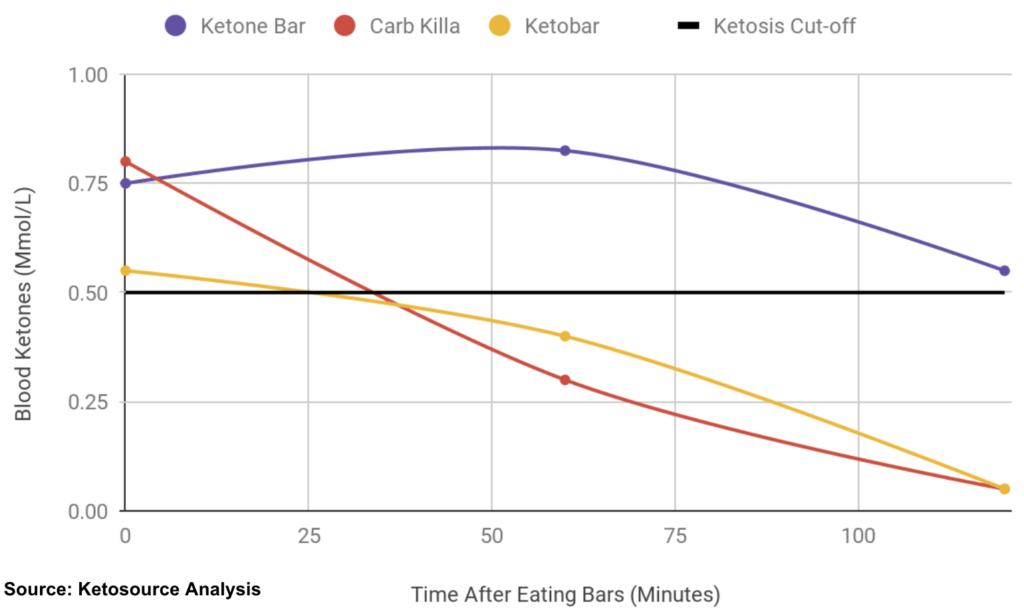
We ran statistical tests to see if results were significant. These tests showed a significant effect of time on blood ketones. There was no significant effect related to the consumption of individual bars. This is likely due to the small sample size (N=9).
Individual Responses to the Ketosource Ketone Bar
The results of the Ketone Bar were more variable for each person. For this reason, we took a closer look at the data to map out the individual responses to the bar.
Figure 3. Individual Blood Ketone Responses to Ketosource Ketone Bars
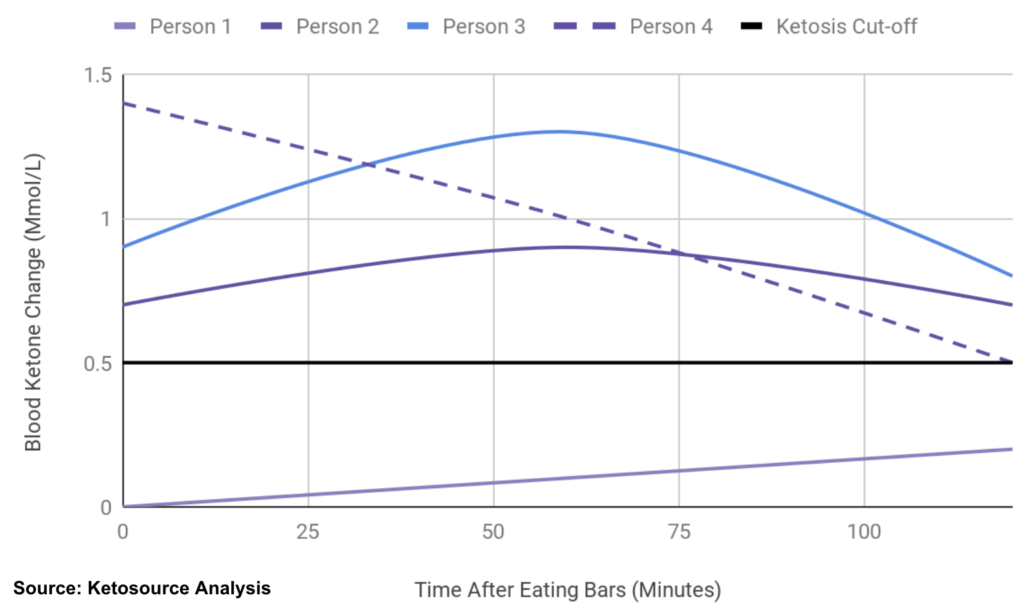
Three out of the four people who took the Ketone Bar had the expected keto response. One person had the opposite response which was unexpected (Person 4 – the dotted line).
There were 3 scenarios:
- Two out of four people (Person 2 and 3) showed an increase in ketones after 1 hour that then returned to baseline level at the second hour or a steady increase in ketones levels over the course of the two hours.
- Person 1 had zero ketones at baseline (0.0 mmol/L). This person noted an increase in ketone levels over the two hours after eating the 2 bars.
- Person 4 (the dotted line) had an unexpected response and saw a decrease in ketones over the two hour period. This is unexpected because it does not align with the results of a previous N = 38 trial with the Ketone bars. Repeat tests will be carried out with this volunteer to understand A) if it is his typical response, and B) try to identify the reason/ mechanism for his atypical response. This page will be updated later with any further experimental data.
Analysis: What Could Explain These Results?
Differing Ketogenic Ratios
It would have been possible to predict the non-keto responses of the two low carb high protein bars (Carb Killa Bar, KetoSlim) by examining their macro profiles provided in their nutritional information label.
The Low Carb High Protein bars have different macro breakdown compared to the High Fat High Fibre bar.
Using the keto ratio (Fat divided by Carbs + Protein) illustrates the large differences between the bars. A classic keto diet is said to have a ratio of 4.0, while moderate keto diet ratios are said to be of between 2.0 to 3.0.
Table 2. Nutritional Information of Bars and Calculation of Ketogenic Ratios
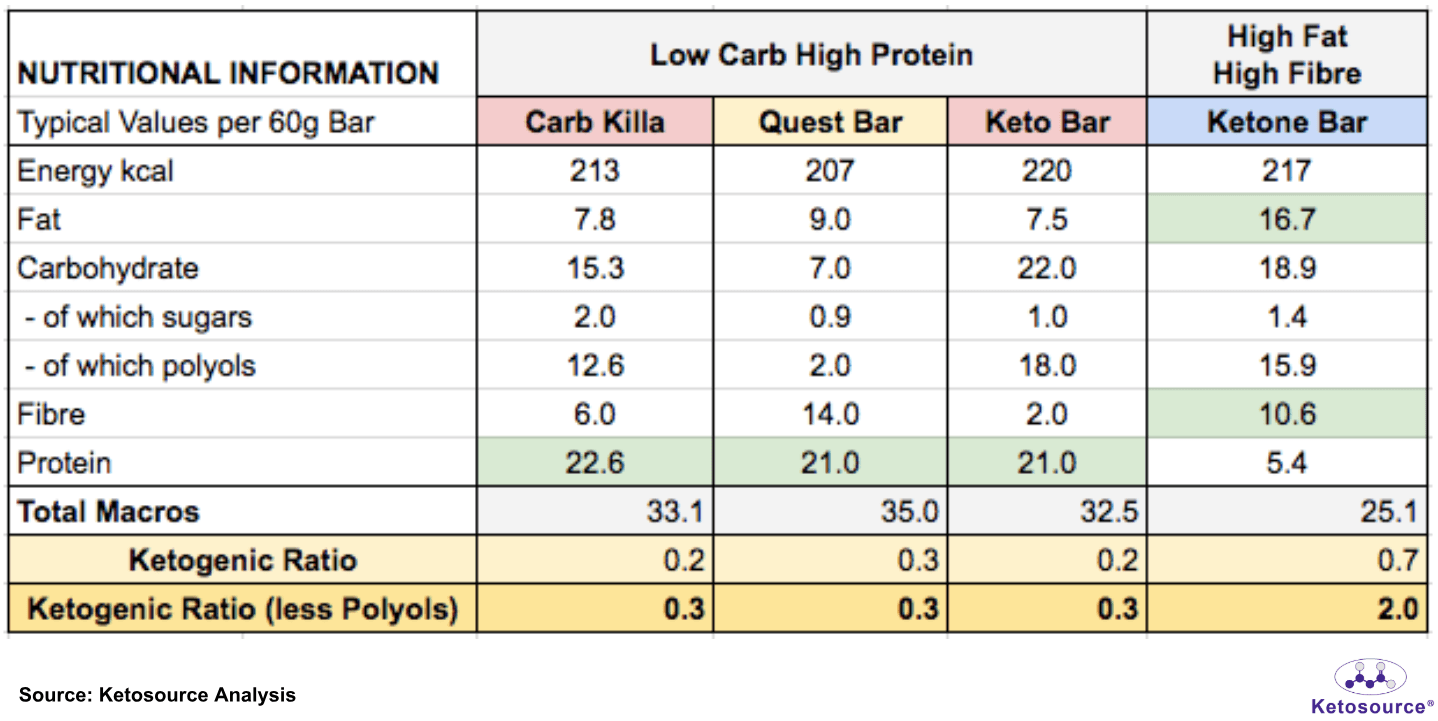
Note: Green highlight shows where the bars’ macro breakdowns differ significantly.
The polyols are currently accounted for in the “Carb” section of nutrition information/ facts labels. However, since polyols typically do not have any impact on blood glucose or ketones it’s useful to remove them.
Using the adjusted keto ratio (without polyols), the Ketone Bar has a moderate keto ratio of 2.0. The other two low carb high protein bars have very low ratios of 0.3. From a keto ratio perspective, they would be expected to not have a keto response (and thus lower blood ketones).
Ketogenic Profiles and Ratios
To be a true ‘keto’ food, a product should have a ‘keto profile’. It should not significantly decrease ketone levels in the blood.
Although keeping blood ketones up is not necessary for everyone, many people look to avoid foods that may ‘kick them out of ketosis’.
Following a keto diet is extremely personal. The exact macro breakdown and how you follow it will depend on your health goals. Not all foods that are deemed ‘keto’ will fit into the confines of each adjusted macro breakdown. Therefore, it is best to test the blood glucose and blood ketone response to a product before adding it to your diet for the long term.
Figure 4. Ketogenic Diet Ratios Vs ‘Keto’ Bar Ratios
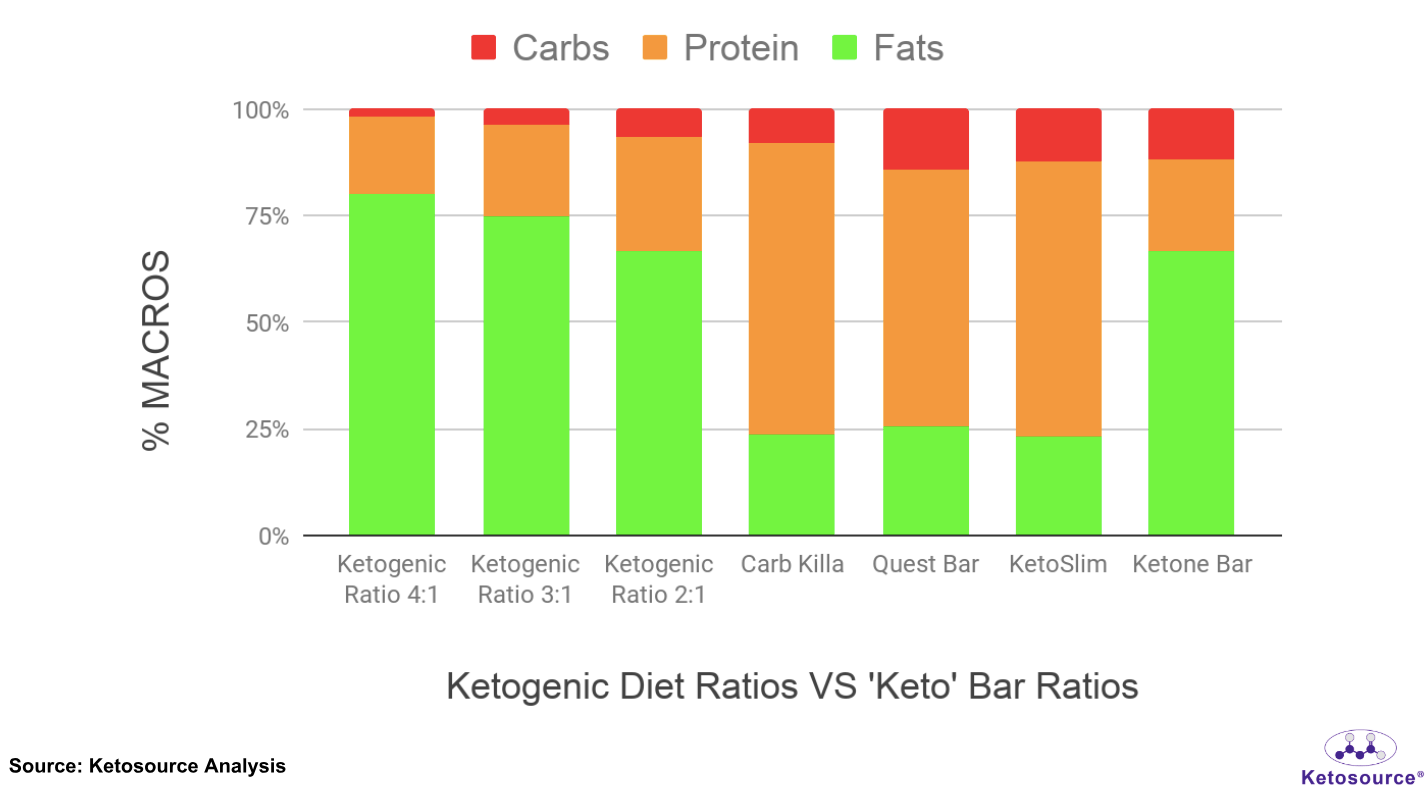
The chart above shows a chart of the three most common keto diet ratios, 4:1, 3:1 and 2:1. You can see the approximate breakdown of carbs, fats and proteins for each subtype.
The macro breakdown and profile of each ‘keto’ bar are shown above. As you can see, the Ketone Bar is the only bar with a true keto profile similar to the 2:1 ratio keto diet subtype.
Non-Ketogenic Ingredients
Going beyond the macro breakdown of foods is often helpful in understanding their keto profile.
The Carb Killa Bar and the KetoSlim contain ingredients which have previously been noted as not having a keto profile.
The Carb Killa Bar contains Maltitol and Polydextrose. These are polyols and fibres within the nutritional information and thus were not removed in our ‘keto ratio’ analysis with the adjusted ratio.
Previous testing has shown that the polyol Maltitol increases blood glucose (and thus reduces blood ketones). In addition, the fibre Polydextrose both increases glucose and reduce blood ketones.
The KetoSlim also contains Maltitol as well as ‘Maltitol Syrup’. It also contains Tapioca Starch, an ingredient that may have a non-keto response.
Why Do Ketones Increase for the Ketone Bar?
The Ketone Bar showed an increase in blood ketones for 3 people at 1 hour after eating.
Even keto foods (foods with a keto ratio) do not typically raise blood ketones after ingestion. Instead, ketones rise over time (e.g. over course of a day) in response to an overall diet with a keto profile.
However, the ketone bar contains C8 MCT oil and C8 MCT oil powder. C8 MCT oil is effective at raising blood ketones (see review of the literature here).
Is Everyone Following a Ketogenic Diet in Ketosis?
Not everyone following a keto diet is in a state of ketosis (>0.5mmol blood ketones).
Two participants following a keto diet had blood ketone values of 0.0 at baseline. Both had not previously tested their blood ketones – but assumed, based on their diet, that they were.
This highlights the value of ‘blood testing’ when following a keto diet. It may also show that people need to follow personalised diets in order to ensure they are in ketosis.
What about Quest Bars, Are They Ketogenic?
Another popular low carb bar is the Quest Nutrition Protein Bar Range.
Following the experiments above, two members of the Ketosource team tested 120g (2 bars) each and measured their ketone and glucose response.

Figure 5. Average Relative Blood Ketone Values for Quest Bar for 3 Hours After Eating
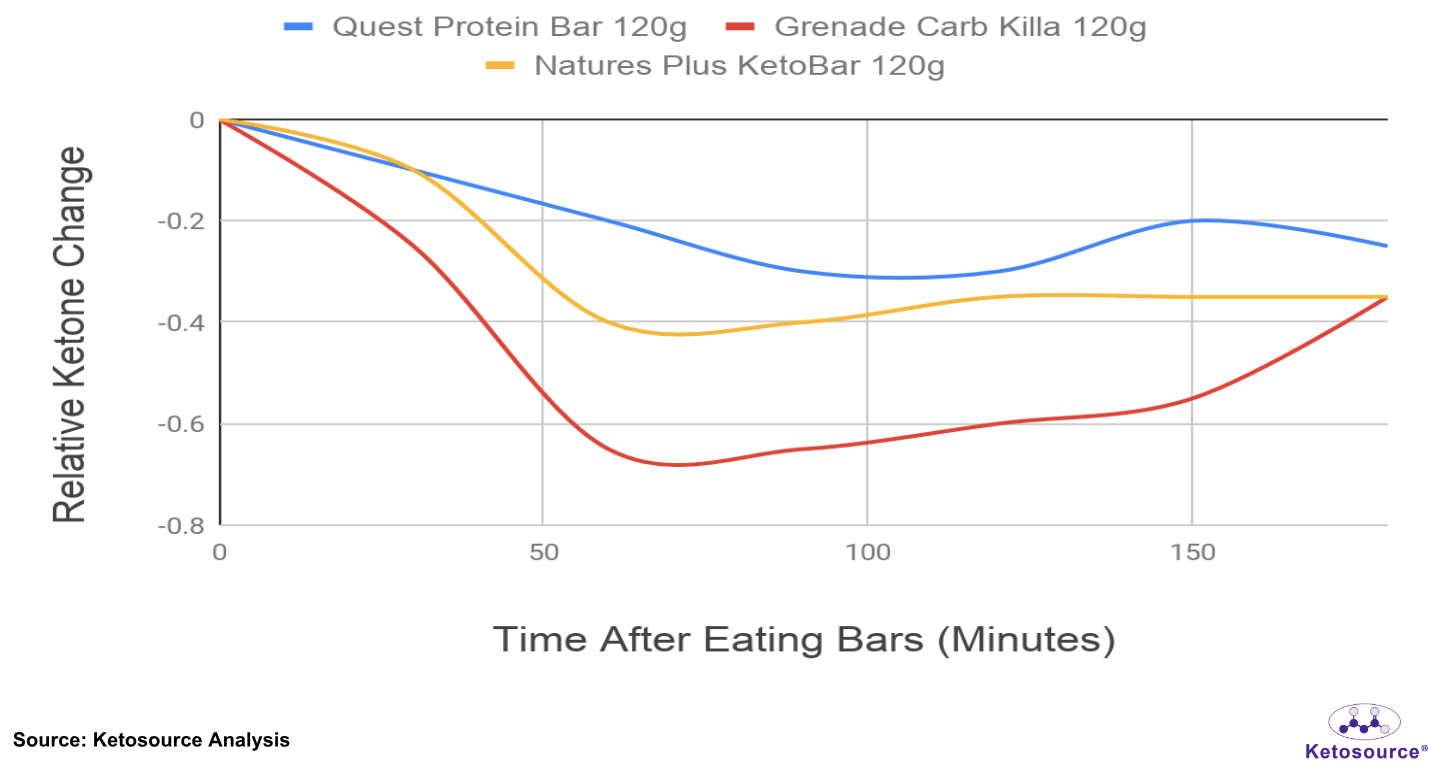
Figure 6. Average Relative Blood Glucose Values for Quest Bar for 3 Hours After Eating
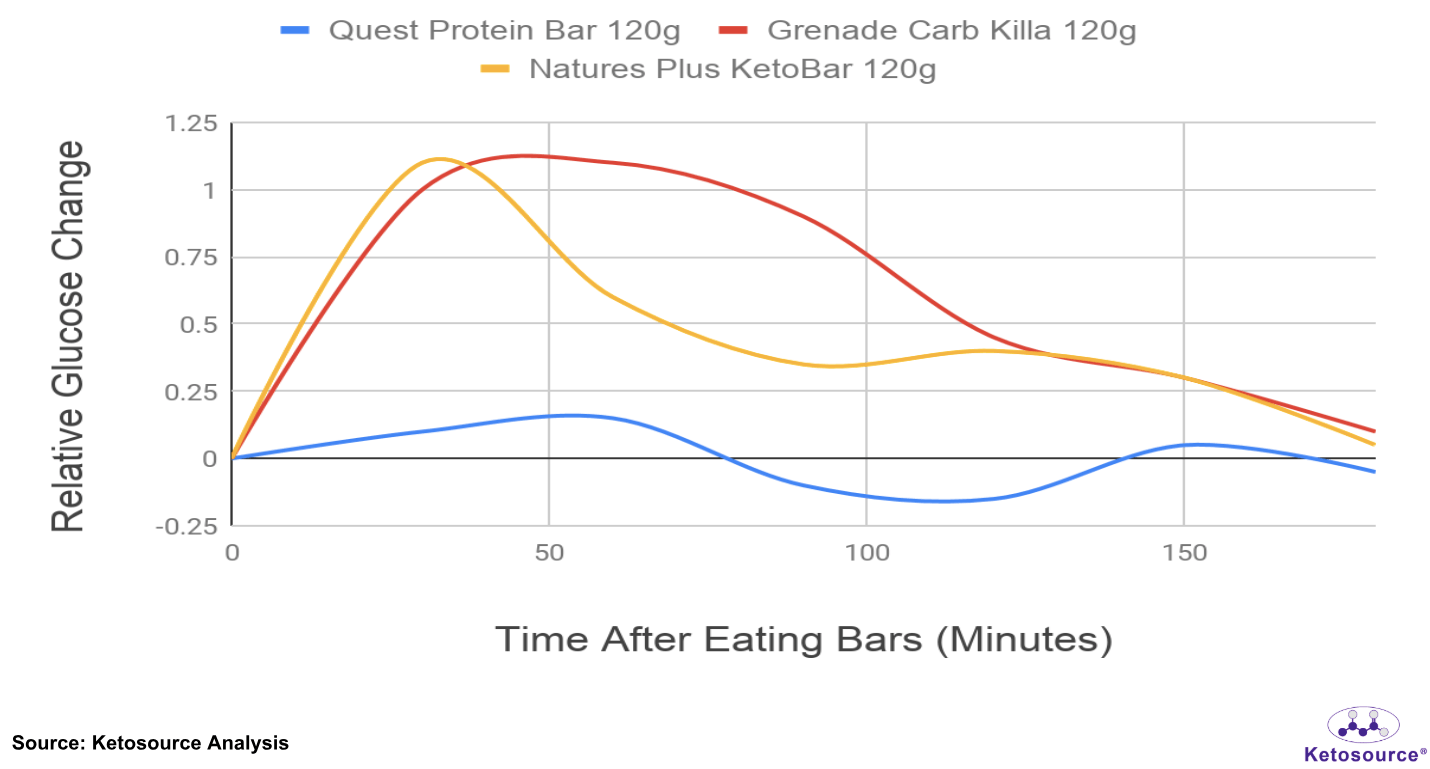
Quest Bar Test Results
As you can see from the results, both the Carb Killa Bar and KetoSlim had quite a negative impact on both blood glucose and ketone values in the two participants.
The Quest Protein Bar (Choc Chip Cookie Dough Flavour) had a different effect on glucose and ketones. Though glucose increased by over 1mmol in the KetoSlim and Carb Killa Bar, the Quest Protein Bar only increased glucose by just under 0.25mmol.
At the two hour mark after eating, the Quest Protein Bar even reduced blood glucose levels, returning back to baseline at the three hour mark.
Ketone levels dropped by an average of 0.4mmol and 0.65mmol at one hour post eating for the KetoSlim and Carb Killa Bar respectively. The Quest Protein Bar, on the other hand, had only dropped by approximately 0.2mmol at the one hour mark, with a total drop of 0.3mmol at 100 minutes. This is exceptionally different to the KetoSlim and Carb Killa Bar which had a similar impact on ketones and glucose.
What About Ingredients?
The ingredients in the Quest Protein Bar may be the reason for the more favourable result. Though the Quest Protein Bar does not have a ‘ketogenic profile’, many of its ingredients are ‘keto friendly’, for example, erythritol sweetener and stevia leading it to be the more favourable bar out of the three.
In the next experiment, the Ketosource team members will compare these three bars against the Ketone Bar which has a ‘ketogenic/keto profile’.
Post Analysis – Strengths and Limitations
We tested 120g (approximately two bars of each type) to make sure that we saw a clear effect on blood ketones and blood glucose levels.
We wanted to see if each product had a true keto profile. These effects may not have been apparent enough if we consumed less than 120g.
There was one clear limitation of this bar trial:
As there were only nine participants in this trial, there were not enough people for a meaningful analysis. Future studies should have larger sample sizes. The outcomes and findings of this trial are to inform and encourage the practice of N=1 experiments.
Finally, future research will be a follow-up experiment with a standard dose of 60g or one bar. This will be a true reflection of what most people would consume and will give a realistic assessment of the impact one bar will have on blood glucose and ketone levels.
Final Thoughts
These results show that neither the Carb Killa Bar nor the KetoSlim is ketogenic. To our knowledge, neither of these bars has been tested for keto diet compliance previously.
Nature’s Plus claim that their KetoSlim bar is ‘keto’ and they refer to it as ‘ketogenic’. This is misleading when it A) does not have a ketogenic profile, and B) when tested decreases ketone levels in the blood.
In the case of the Carb Killa Bar, no claims are made by the company as to its ketogenic profile. So it is likely that people have just assumed it is keto based on its low carb profile.
This does not mean these products cannot be consumed on a keto diet, but caution must be taken, especially if the bars become commonplace in the diet, and if the individual has a specific reason to maintain ketosis.
Given the results for the Ketone Bar were not conclusive further testing and experiments are needed. In particular, follow up repeat testing should be done with Person 4 (the outlier). In addition, a larger well-controlled experiment of N = 20 or more should be designed and run to further validate the results – and understand if some individuals respond differently to it (similarly to Person 4).
Live Video Streams of the Experiment at Keto London
The experiments run at Keto London are streamed live with video on the Keto London facebook page.
Part 1: Starting the Experiment Watch here to see the volunteers complete their questionnaires, take their baseline blood ketone readings and start eating their bars.
Part 2: Results of the Experiment and Discussion Watch here to see the presentation on ‘ketogenic foods’, the volunteers take their next two blood ketone readings and the final results of the experiment are presented and discussed.
Summary: The Takeaways
- Not everyone who thinks they are following a keto diet is actually in a state of ketosis (>0.5mmol). If you are following a keto diet you should validate it at least once using blood testing (On Call Dual GK Monitor) to confirm you are in ketosis.
- Neither the Carb Killa Bar nor the KetoSlim is keto by our definition. If you are on a keto diet, you should avoid these bars (and potentially other low carb high protein bars) if you’re looking to maintain ketosis.
- The Ketosource Ketone Bar is ketogenic (and additionally increases ketones for most people). But, there may be some individuals who respond differently to it. We need to run further experiments to confirm this, and then if some individuals have a different response we would run an experiment to identify why these people respond in this way.